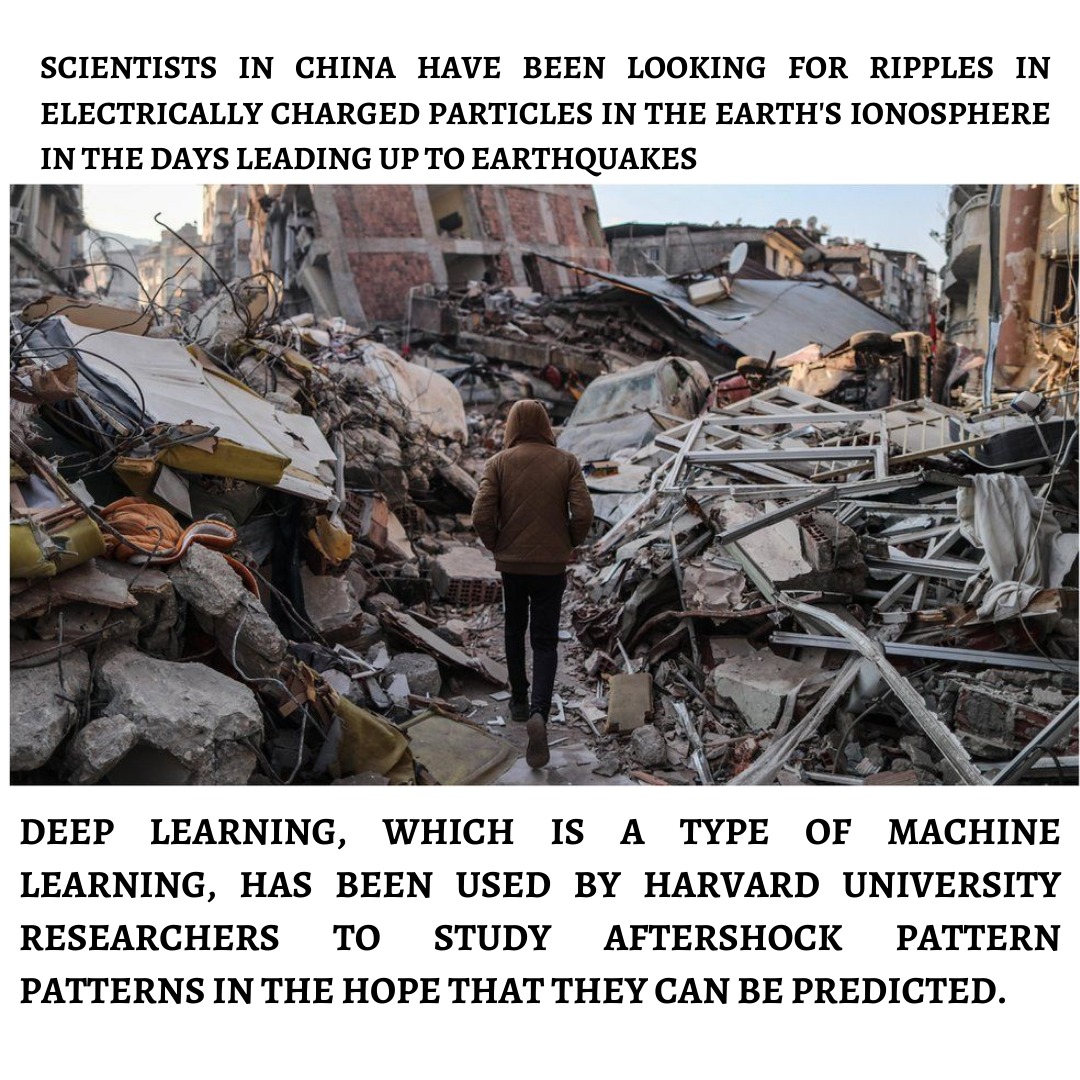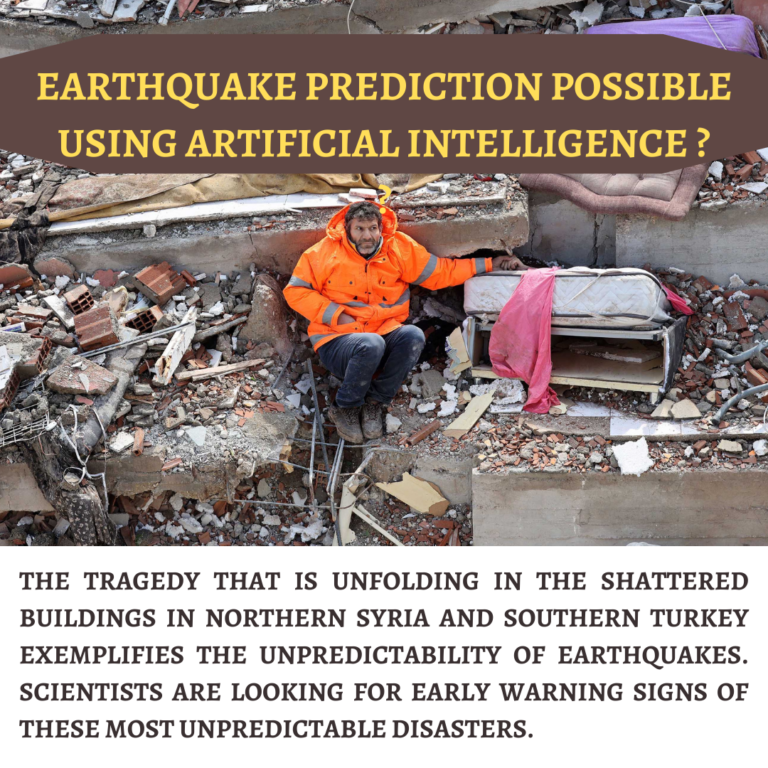Is it possible to predict earthquakes?
Thousands of people have died in the two devastating earthquakes that struck northern Syria and south-eastern Turkey. Many more have been injured or left without a place to stay. When the first 7.8-magnitude earthquake struck on February 6, the majority of the victims would have been asleep inside when their homes came crashing down on top of them.
 As the first earthquake’s seismic waves reverberated around the world, the sudden flashes of activity on semiologists’ sensitive instruments were the first indication that a major disaster was about to happen. A second large earthquake of magnitude 7.5 struck a few hours later.The magnitude of the tremors was particularly high due to their relative shallowness. The United States Geological Survey has also issued a warning about the significant dangers posed by landslides and ground liquefication as a result of the shaking, which is continuing to be felt in the region as aftershocks continue to occur. However, some people are wondering why we didn’t anticipate this sooner as the world rushes to assist the devastated communities on either side of the border between Turkey and Syria.
As the first earthquake’s seismic waves reverberated around the world, the sudden flashes of activity on semiologists’ sensitive instruments were the first indication that a major disaster was about to happen. A second large earthquake of magnitude 7.5 struck a few hours later.The magnitude of the tremors was particularly high due to their relative shallowness. The United States Geological Survey has also issued a warning about the significant dangers posed by landslides and ground liquefication as a result of the shaking, which is continuing to be felt in the region as aftershocks continue to occur. However, some people are wondering why we didn’t anticipate this sooner as the world rushes to assist the devastated communities on either side of the border between Turkey and Syria.
In point of fact, the science of earthquake prediction is extremely challenging. Although there are frequently minute signals that can be detected in seismic data after an event has occurred, it is much more difficult to know what to look for and use that information to make forecasts in advance.
Chris Marone, a professor of geosciences at Sapienza University of Rome in Italy and Penn State University in Pennsylvania, USA, states, “When we simulate earthquakes in the laboratory, we can see all these little failures happening – there is some cracking and some flaws that appear first.” However, there is a great deal of uncertainty regarding the reason why we frequently do not observe foreshocks or signs of a large earthquake out in nature.”
Since at least the 1960s, geologists have attempted to predict earthquakes using current scientific techniques without much success. According to Marone, the complexity of the global fault systems accounts for a significant portion of this. Additionally, there is a lot of seismic noise—the Earth is constantly grumbling and rumbling away—which, when combined with the human-caused clatter of traffic, building work, and everyday life, makes it difficult to discern clear signals.
The United States Geological Survey says that three things are needed to make a good earthquake prediction: when the event will occur, where it will occur, and how big it will be. They assert that no one can do that with any certainty at this time.
Instead, geologists make “hazard maps,” which are their best guesses about the likelihood of an earthquake occurring within a few years. Even though these can help with some planning, like raising building standards in the most dangerous areas, they don’t give the public enough advance warning to allow them to evacuate or find shelter. Additionally, not everyone who lives in an earthquake zone is able to afford the infrastructure that is required to withstand significant shaking.
There were a lot of factors in Turkey and Syria that meant buildings were in a state where they were ready to pancake and fail.” In the 1970s and 1980s, seismic reinforcement codes were implemented in a lot of the Western world. However, it costs a lot to construct and upgrade buildings.
Therefore, scientists have instead been looking for ways to improve the accuracy of earthquake predictions. Researchers have looked for clues in a wide range of places, including animal behavior and electrical disturbances in the Earth’s upper atmosphere, in addition to seismic signals.

However, recent years have seen a rise in interest in the capability of artificial intelligence to recognize subtle signals that humans miss. Patterns that could be used to predict future events can be found in the vast amounts of data from previous earthquakes that can be analyzed by machine-learning algorithms.
“This type of machine-learning-based prediction has produced a lot of interest,” according to Marone. He and his colleagues have been developing algorithms to detect failures in laboratory-simulated earthquake faults for the past five years. Using granite blocks the size of a fist, they can recreate the stress buildup and friction that might occur at a fault. They call these “labquakes” because the pressure builds until the fault slips.
“Elastic waves travel through the fault as it breaks little by little,” says Marone. In the laboratory, we can predict when the failure will occur based on these changes in elastic properties and the noise from foreshocks in the fault zone itself. Although we are not there yet, we would love to bring this to Earth.
Applying AI’s predictive capabilities to the larger, more complex fault zone environment is significantly more challenging.
For instance, in the days preceding earthquakes brought on by shifts in the magnetic field above fault zones, researchers in China have been looking for ripples in electrically charged particles in the ionosphere of the Earth. For instance, a group led by Jing Liu at the Institute of Earthquake Forecasting in Beijing claimed that they could observe disturbances in the electrons in the atmosphere above the epicentre of the earthquake that struck Baja, California, ten days before it struck in early April 2010.
By examining the shifts in the amount of electrons present in the ionosphere over the course of the past two decades, a different Israeli group recently asserted that they were able to use machine learning to accurately predict large earthquakes 48 hours in advance with an accuracy of 83%.
 It is evident that China is placing its hopes in these ionosphere clues. The China Seismo-Electromagnetic Satellite (CSES) was launched in 2018 by China to look for electrical anomalies in the ionosphere of the Earth. Last year, researchers at the China Earthquake Network’s Centre in Beijing claimed to have observed drops in the ionosphere electron density up to 15 days prior to the May 2021 and January 2022 earthquakes that struck the Chinese mainland.
It is evident that China is placing its hopes in these ionosphere clues. The China Seismo-Electromagnetic Satellite (CSES) was launched in 2018 by China to look for electrical anomalies in the ionosphere of the Earth. Last year, researchers at the China Earthquake Network’s Centre in Beijing claimed to have observed drops in the ionosphere electron density up to 15 days prior to the May 2021 and January 2022 earthquakes that struck the Chinese mainland.
According to Mei Li, one of the researchers at the China Earthquake Network Centre, “an energy transfer can occur between the lithosphere and the two layers above – that is, the atmophsere and the ionosphere.” However, she asserts that the mechanism by which this occurs remains contentious. She also warns that their findings are still far from being able to predict an approaching earthquake, even with the satellite data.
According to her, “the ionospheric anomaly can appear around the epicentre of an earthquake as well as its magnetically conjugated point in the other hemisphere, which gives us more difficulty to confirm the location of the forthcoming event.”
Animal prediction
There have been reports for millennia that animals get scared and run away in fear before earthquakes, but it’s hard to make sense of these observations.
The behavior of animals does not always allow for precise prediction. There are rumors that unusual animal behavior helped predict one earthquake in China several decades ago, but the feat has never been repeated.
However, researchers at Germany’s Max Planck Institute for Animal Behaviour are documenting the behavior of cows, sheep, and dogs in Italy’s earthquake-prone regions. The researchers claim that the closer an animal was to the epicentre of imminent tremors and earthquakes, the earlier they altered their behavior. Learn more about the creatures that foretell disasters.)
The immediate aftermath of an earthquake is one area where artificial intelligence may have a more immediate impact. Tools that use artificial intelligence to classify the damage caused by natural disasters from satellite imagery have been developed by researchers at Tohoku University and Renmin University of China so that governments and rescue teams can be sent where they are most needed. It uses algorithms to evaluate the damage to buildings and determine which ones have been completely destroyed or could be dangerous.Additionally, it is hoped that by assisting in the improvement of the prediction of aftershocks that occur after a major earthquake, machine-learning algorithms might be able to help safeguard rescue workers and earthquake survivors. These can be very dangerous because they can move buildings that were made unstable by the first earthquake and cause more damage.
Deep learning, which is a type of machine learning, has been used by Harvard University researchers to study aftershock pattern patterns in the hope that they can be predicted.

